|
|
|
Sort Order |
|
|
|
Items / Page
|
|
|
|
|
|
|
| Srl | Item |
| 1 |
ID:
166543
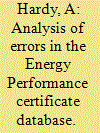

|
|
|
|
|
| Summary/Abstract |
Energy Performance Certificates (EPCs) are the adopted method by which the UK government tracks the progress of its domestic energy efficiency policies. Over 15 million EPCs have been lodged, representing a valuable resource for research into the UK building stock. However, the EPC record has a reputation of containing multiple errors. In this work, we identify many such errors and quantify how common they are. We find that 27% of EPCs in the open EPC record display at least one flag to suggests it is incorrect and estimate the true error rate of the EPC record to be between 36 and 62%. Many of these errors are caused by EPC assessors disagreeing on building parameters such as floor type, wall type and built form. Additionally, flats and maisonettes appear to cause more issues than other property types. This may be due to difficulties in assessing their location in the building and the nature of the surrounding space. We also suggest potential new methods of quality assurance which rely on machine learning and which could allow such errors to be avoided in the future.
|
|
|
|
|
|
|
|
|
|
|
|
|
|
|
|
| 2 |
ID:
150638


|
|
|
|
|
| Summary/Abstract |
China hosts a large amount of building stocks, which is nearly 50 billion square meters. Moreover, annual new construction is growing fast, representing half of the world's total. The trend is expected to continue through the year 2050. Impressive demand for new residential and commercial construction, relative shorter average building lifetime, and higher material intensities have driven massive domestic production of energy intensive building materials such as cement and steel. This paper developed a bottom-up building stock turnover model to project the growths, retrofits and retirements of China's residential and commercial building floor space from 2010 to 2050. It also applied typical material intensities and energy intensities to estimate building materials demand and energy consumed to produce these building materials. By conducting scenario analyses of building lifetime, it identified significant potentials of building materials and energy demand conservation. This study underscored the importance of addressing building material efficiency, improving building lifetime and quality, and promoting compact urban development to reduce energy and environment consequences in China.
|
|
|
|
|
|
|
|
|
|
|
|
|
|
|
|
| 3 |
ID:
112906


|
|
|
|
|
| Publication |
2012.
|
| Summary/Abstract |
Local authorities often rely upon urban energy and carbon modelling tools to develop mitigation policies and strategies that will deliver reductions in greenhouse gas emissions. In this paper the UK example of Newcastle-upon-Tyne is used to critique current practice, noting that important features of urban energy systems are often omitted by bottom-up tools including interactions between technologies, spatial disaggregation of demand, and the ability to pursue over-arching policy goals like cost minimization. An alternative optimization-based approach is then described and applied to the Newcastle case, at the scale of both the whole city and the South Heaton district, and using Monte Carlo techniques to address policy uncertainty. The results show that this new method can help policy makers draw more robust policy conclusions, sensitive to spatial variations in energy demand and capturing the interactions between developments in the national energy system and local policy options. Further work should focus on improving our understanding of local building stocks and energy demands so as to better assess the potential of new technologies and policies.
|
|
|
|
|
|
|
|
|
|
|
|
|
|
|
|
| 4 |
ID:
089003
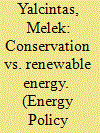

|
|
|
|
|
| Publication |
2009.
|
| Summary/Abstract |
State of Hawaii generates about 90 percent of its electricity from imported fossil fuel sources. Thus, there is pressure from both public and policy makers to reduce the State dependency on foreign fossil fuel sources. To this extend, there are incentives created at State and Federal level for both residential and commercial buildings to install photovoltaic (PV) systems. Although such incentives are necessary for long-term objectives, it is shown in this study that retrofitting inefficient old building-equipment is another viable source to reduce the State of Hawaii's electricity demand. Four case studies are presented to illustrate that building-equipment retrofitting is a viable and necessary tool for increasing the energy efficiency of buildings. Each case study presents an equipment retrofit project electricity savings with its payback periods, and compares with equivalent electricity capacity and economics PV systems in Honolulu, Hawaii. The case studies show that energy savings from retrofit projects ranged from 28% to 61% for individual equipment retrofits. These results indicate that equipment retrofitting with energy-efficient alternatives is about 50% or more cost-effective than installing PV systems. This is so even when large renewable energy tax incentives provided by the Federal and State Governments are taken into account.
|
|
|
|
|
|
|
|
|
|
|
|
|
|
|
|
| 5 |
ID:
177379
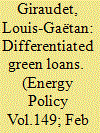

|
|
|
|
|
| Summary/Abstract |
Scaling up home energy retrofits requires that associated loans be priced efficiently. Using a unique dataset of posted loan prices scraped from online simulators made available by French credit institutions, we examine the differentiation of interest rates in relation to project risk. Crucially, our data are immune from sorting bias based on borrower characteristics. We find that greener, arguably less risky, automobile projects carry lower interest rates, but greener home retrofits do not. On the other hand, conventional automobiles carry lower interest rates than do conventional home retrofits, despite arguably similar risk. Our results are robust to a range of robustness checks, including placebo tests. They together suggest that lenders use underlying assets to screen borrower's unobserved willingness to pay, which can cause under-investment in home energy retrofits. We thereby point to a new form of the energy efficiency gap. This has important policy implications in that it can explain low uptake of zero-interest green loan programs.
|
|
|
|
|
|
|
|
|
|
|
|
|
|
|
|
| 6 |
ID:
191366
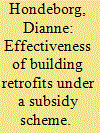

|
|
|
|
|
| Summary/Abstract |
While retrofitting buildings is one of the key elements of reaching climate and energy goals, it is burdened by insufficient speed and depth. Governments have attempted to accelerate deep retrofits via subsidies, but scant evidence exists on these policies’ effectiveness. In this study, we investigate the effectiveness of retrofitting subsidies by using a range of econometric techniques and a unique dataset of over 400 Swiss buildings with 19,000 observations over 11 years. Specifically, we analyze whether retrofits reduce energy consumption, whether subsidized retrofits lead to deeper retrofits than non-subsidized retrofits, and we differentiate the impact by subsidy amount. We find that retrofits reduce average energy use by 10–20%, that the achieved savings through subsidized and non-subsidized retrofits do not differ significantly, and that the subsidy amount is correlated to a reduction in energy use by 0.42 CHF per kWh over a period of 20 years. Our study highlights the importance of policies that enhance retrofit depth, the need to further investigate the causes of the wide variation in retrofitting results, and to consider effectiveness studies within the policy design.
|
|
|
|
|
|
|
|
|
|
|
|
|
|
|
|
| 7 |
ID:
192761
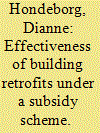

|
|
|
|
|
| Summary/Abstract |
While retrofitting buildings is one of the key elements of reaching climate and energy goals, it is burdened by insufficient speed and depth. Governments have attempted to accelerate deep retrofits via subsidies, but scant evidence exists on these policies’ effectiveness. In this study, we investigate the effectiveness of retrofitting subsidies by using a range of econometric techniques and a unique dataset of over 400 Swiss buildings with 19,000 observations over 11 years. Specifically, we analyze whether retrofits reduce energy consumption, whether subsidized retrofits lead to deeper retrofits than non-subsidized retrofits, and we differentiate the impact by subsidy amount. We find that retrofits reduce average energy use by 10–20%, that the achieved savings through subsidized and non-subsidized retrofits do not differ significantly, and that the subsidy amount is correlated to a reduction in energy use by 0.42 CHF per kWh over a period of 20 years. Our study highlights the importance of policies that enhance retrofit depth, the need to further investigate the causes of the wide variation in retrofitting results, and to consider effectiveness studies within the policy design.
|
|
|
|
|
|
|
|
|
|
|
|
|
|
|
|
| 8 |
ID:
124370


|
|
|
|
|
| Publication |
2013.
|
| Summary/Abstract |
The UK Government has unveiled an ambitious retrofit programme that seeks significant improvement to the energy efficiency of the housing stock. High quality data on the energy efficiency of buildings and their related energy demand is critical to supporting and targeting investment in energy efficiency. Using existing home improvement programmes over the past 15 years, the UK Government has brought together data on energy efficiency retrofits in approximately 13 million homes into the Homes Energy Efficiency Database (HEED), along with annual metered gas and electricity use for the period of 2004-2007.
This paper describes the HEED sample and assesses its representativeness in terms of dwelling characteristics, the energy demand of different energy performance levels using linked gas and electricity meter data, along with an analysis of the impact retrofit measures has on energy demand. Energy savings are shown to be associated with the installation of loft and cavity insulation, and glazing and boiler replacement. The analysis illustrates this source of 'in-action' data can be used to provide empirical estimates of impacts of energy efficiency retrofit on energy demand and provides a source of empirical data from which to support the development of national housing energy efficiency retrofit policies.
|
|
|
|
|
|
|
|
|
|
|
|
|
|
|
|
| 9 |
ID:
168644
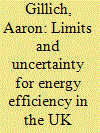

|
|
|
|
|
| Summary/Abstract |
The UK government's Clean Growth Strategy unambiguously described the decarbonisation of heat as the UK's greatest policy and technical challenge in meeting our carbon targets. Maximising the potential for energy efficiency in the existing domestic stock is critical to the low-carbon heat transition. Good information exists on the technical potential for energy efficiency measures in the UK stock, however, a lack of knowledge about current stock conditions and in-use factors places considerable uncertainty on how much of this technical potential is achievable in practice.
|
|
|
|
|
|
|
|
|
|
|
|
|
|
|
|
| 10 |
ID:
163549
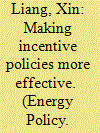

|
|
|
|
|
| Summary/Abstract |
The building sector is responsible for a major share of energy consumption, with the most energy being consumed during the operation stage of buildings. Energy-efficiency retrofit (EER) policies have been promoted by numerous countries. However, the effectiveness of these incentive policies has been insufficient, a main reason being the agency problem between the government and building owners. In addition, most policies ignored the diversity of buildings and building owners, resulting in a lack of reaction from owners. To address this problem, this study proposed an agent-based model for policy making on EER. The model defined the government and owners as agents and their decision-making behaviors were modeled with principal-agent theory. A platform based on the proposed model was then developed and the incentive policy was optimized under different circumstances. To verify the effectiveness of the proposed model, three policy scenarios were compared on the platform, which are the policy by the proposed model, the incentive policy in Shanghai and Shenzhen, China. The results showed that the incentive policy based on the proposed model has the best performance on energy savings, returns on investment, and leverage effects. A sensitivity analysis indicated that the government should pay more attention to energy price.
|
|
|
|
|
|
|
|
|
|
|
|
|
|
|
|
| 11 |
ID:
176788


|
|
|
|
|
| Summary/Abstract |
Energy use in British homes is a significant contributor to national greenhouse gas emissions, and the improvement of energy efficiency in residential buildings has long been an important topic in policy discussions. The lack of investment in energy-saving measures is particularly challenging in the private rented sector, and there are significant research and data gaps in understanding the retrofit behaviour of private landlords. In this study, we present the results of a detailed survey on retrofit behaviour of 1069 British private landlords. The survey assesses the engagement of landlords with 18 different energy efficiency measures, as well as their attitudes, perceptions, norms and a number of other characteristics. We use the data collected in the survey to produce 7 behavioural “typologies” of landlord retrofitters, by clustering respondents based on their socio-demographic and business characteristics. In addition to providing descriptive evidence of landlords' retrofit behaviour, our results reveal a number of opportunities for segmenting the landlord population into target groups for future policy interventions. By tailoring retrofit incentives to the needs and motivations of these groups, policy-makers can effectively engage landlords with specific energy-saving technologies, increasing the likelihood of retrofit uptake and accelerating the transition to an energy-efficient private rented sector.
|
|
|
|
|
|
|
|
|
|
|
|
|
|
|
|
| 12 |
ID:
181763


|
|
|
|
|
| Summary/Abstract |
Buildings in the EU are responsible for 40% of energy use, with approximately 75% of buildings classed as energy inefficient. Many energy efficiency technologies have failed to deliver on the promised savings. This paper measures the extent to which residential dwelling retrofit delivers real energy savings in Ireland using a unique dataset of whole-home energy use (n = 8,572 households) over a two-year period. It is one of the largest studies of retrofit using whole-home energy data for a general housing sample, who do not disproportionately experience fuel poverty. It uses whole-home energy data to capture potential fuel switching induced by retrofit. Finally, this study addresses concerns regarding self-selection issues associated with the decision to undergo a retrofit by comparing with a second control group of homes that received a retrofit prior to the observation period.
|
|
|
|
|
|
|
|
|
|
|
|
|
|
|
|
| 13 |
ID:
119792


|
|
|
|
|
| Publication |
2013.
|
| Summary/Abstract |
Ireland's housing stock has been identified as being amongst the least energy efficient in Northern Europe. Consequently, atmospheric emissions are greater than necessary. Government funded schemes have been introduced to incentivise the uptake of thermal retrofit measures in the domestic Irish market. A study of Ireland's housing highlights the dominance of detached houses (43%), 72% of which are rurally located and are predominantly heated with fuel oil. This paper investigates the economic and carbon case for thermal retrofit measures to the existing detached, oil centrally heated, rural housing stock. The study found the case for energy efficiency measures to be categorical and supports the Irish Government's focus on energy efficiency policy measures. Thermal retrofit measures in the detached housing stock have the potential to realise an averaged 65% theoretical reduction in heating costs and CO2 emissions for houses constructed prior to 1979 (coinciding with the introduction of building regulations) and around 26% for newer homes, thus offering a significant contribution (44%) to Ireland's residential carbon abatement projections and hence in meeting the EU's directives on energy and carbon. The greatest savings (36%) of Ireland's carbon abatement projections result from improving the energy efficiency of the pre 1979 stock.
|
|
|
|
|
|
|
|
|
|
|
|
|
|
|
|
| 14 |
ID:
166405


|
|
|
|
|
| Summary/Abstract |
Improving energy efficiency, de-carbonising heating and cooling, and increasing renewable microgeneration in existing residential buildings, is crucial for meeting social and climate policy objectives. This paper explores the challenges of financing this ‘retrofit’ activity. First, it develops a typology of finance mechanisms for residential retrofit highlighting their key design features, including: the source of capital; the financial instrument(s); the project performance requirements; the point of sale; the nature of the security and underwriting the repayment channel and customer journey. Combining information from interviews and documentary sources, the paper explores how these design features influence the success of the finance mechanisms in different contexts. First, it is shown that a low cost of capital for retrofit finance is critical to the economic viability of whole-house retrofits. Second, by funding non-energy measures such as general improvement works, finance mechanisms can enable broader sources of value that are more highly prized by households. Thirdly, mechanisms that reduce complexity by simplifying the customer journey are likely to achieve much higher levels of uptake. Most importantly we discuss how finance alone is unlikely to be a driver of demand for whole-house retrofit, and so instead should be viewed as a necessary component of a much broader retrofit strategy.
|
|
|
|
|
|
|
|
|
|
|
|
|
|
|
|
|
|
|
|
|